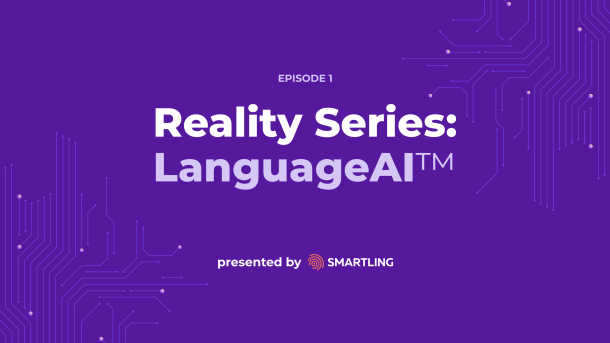LanguageAI is a hot topic in the translation and localization industry. There is a lot of excitement and hype around the potential for this technology to be massively transformative — and also a lot of confusion and consternation around what that actually means from a practical, day-to-day perspective.
How will AI and machine learning technologies apply to you? How will they apply to your company? And how will they apply to your customers?
In this first episode of our Reality Series, Smartling’s founder Jack Welde sits down with Olga Beregovaya (VP of AI and Machine Translation) and Andrew Batwash (Associate Director of Language Services) to discuss the impact of AI on localization. They talk through some common myths and realities and explore where the industry is heading.
What is LanguageAI?
Let’s start with what it’s not. LanguageAI is not just another word for machine translation (MT) — although MT is a major component of LanguageAI.
When we talk about LanguageAI, we’re referring to all the ways we can apply AI and machine learning (ML) technologies to make the entire translation process more efficient. It encompasses both operational or workflow improvements and the translation of the content itself.
For example, AI can be leveraged to help determine which MT engine should be used depending on the language pair and type of content. It can facilitate the consistent application of a company’s linguistic assets — whether or not the content is translated using MT or via human translators. It can help with tag handling. None of these tweaks to the workflow are insignificant.
Then, the other part of the LanguageAI equation is MT and natural language processing (NLP) applications. That includes aspects that have gotten the bulk of the recent buzz: sentiment analysis, summarization, and text generation.
LanguageAI creates opportunities to work smarter, not harder
Language professionals have long since used technology to streamline the translation process. Computer-assisted translation (CAT) tools, for example, have been around for quite some time. But recent developments in AI have prompted a paradigm shift in how the language industry approaches translation.
Previously, humans did the heavy lifting, and AI played a supporting role. Now, the opposite is true.
However, that doesn’t mean AI technologies are an immediate job killer either. There are limitations to what AI can do. Using AI to streamline the translation process further and generate significant cost savings is possible — but only if you do so strategically and keep the human experts in the loop.
Set your expectations. It’s important to understand what LanguageAI can and cannot do. There are still areas where the expertise of professional linguists will be invaluable e.g., reviewing MT output to flag false fluency issues (where sentences are grammatically correct but fall short elsewhere), navigating cultural sensitivities, and creating emotional engagement.
Design your strategy. Your localization strategy should be driven by your business objectives and how you plan to measure success. Define those first, then focus on calibrating your localization approach.
Be intentional about how different content types are treated within the localization workflow. Some content types lend themselves to MT, while others are better left to a human. And still others benefit from a hybrid approach.
Finally, invest in your linguistic assets to help personalize your content — regardless of whether or not that content will go through an MT workflow or a human-driven workflow.
- Practice good data hygiene.
To provide any type of ML output, you need a large corpus of content that the machine can use to learn from. Companies can draw from their translation memories, but it’s critical that these are as clean as possible — e.g., don’t contain deprecated terminology or translation inconsistencies. In addition, companies must take steps to ensure data security.
Smartling helps companies leverage LanguageAI to maximize ROI
It is an exciting time to be involved in the translation and localization industry. LanguageAI has ushered in new possibilities for companies looking for scalable ways to enrich their interactions with audiences worldwide. But greater engagement hinges on keeping in mind the following:
It’s not an either/or situation. In fact, opting to take one route over the other — for instance, going from all human to all AI — is a recipe for failure.
Instead, it’s both – humans and machines.
There is a sweet spot somewhere in the middle. Although the specific approach varies from company to company depending on business objectives, those companies that leverage the strengths of humans and LanguageAI to maximum effect will have a competitive advantage.
Here’s where Smartling comes in. Smartling’s translation management solution and expert language services can help you determine where and how to leverage professional linguists and LanguageAI to maximize your ROI on your localization program.
Want to learn more about the future of LanguageAI and how Smartling can help you thrive in this exciting time? Watch the session in its entirety.








